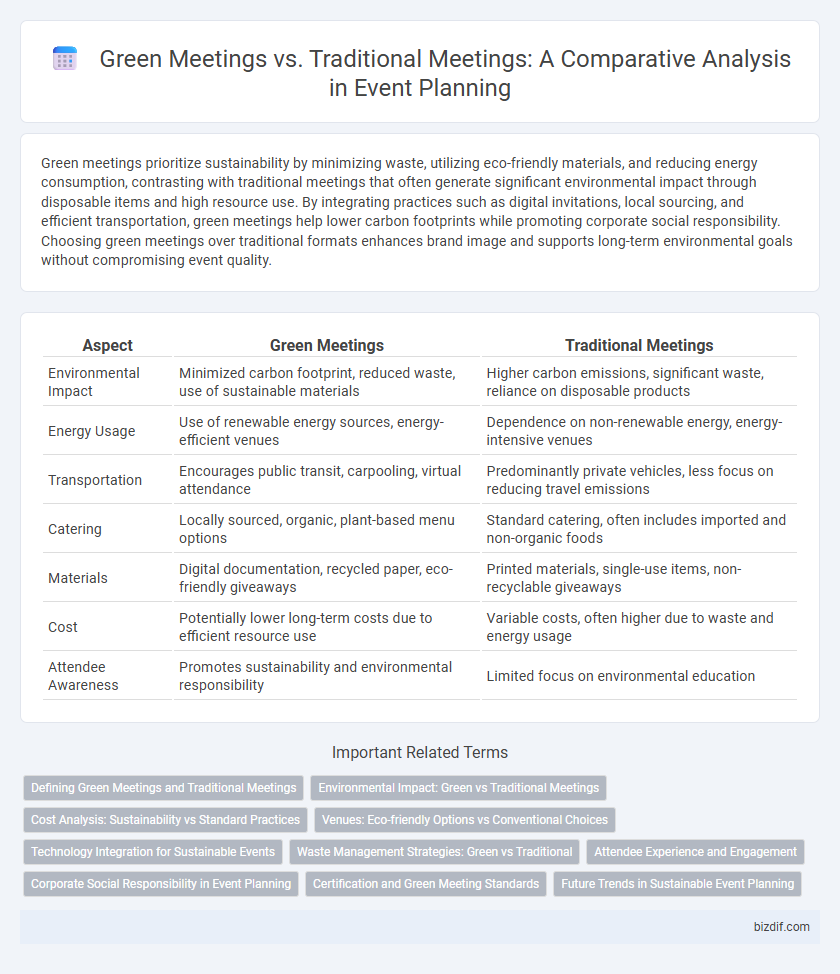Green meetings prioritize sustainability by minimizing waste, utilizing eco-friendly materials, and reducing energy consumption, contrasting with traditional meetings that often generate significant environmental impact through disposable items and high resource use. By integrating practices such as digital invitations, local sourcing, and efficient transportation, green meetings help lower carbon footprints while promoting corporate social responsibility. Choosing green meetings over traditional formats enhances brand image and supports long-term environmental goals without compromising event quality.
Table of Comparison
| Aspect | Green Meetings | Traditional Meetings |
|---|---|---|
| Environmental Impact | Minimized carbon footprint, reduced waste, use of sustainable materials | Higher carbon emissions, significant waste, reliance on disposable products |
| Energy Usage | Use of renewable energy sources, energy-efficient venues | Dependence on non-renewable energy, energy-intensive venues |
| Transportation | Encourages public transit, carpooling, virtual attendance | Predominantly private vehicles, less focus on reducing travel emissions |
| Catering | Locally sourced, organic, plant-based menu options | Standard catering, often includes imported and non-organic foods |
| Materials | Digital documentation, recycled paper, eco-friendly giveaways | Printed materials, single-use items, non-recyclable giveaways |
| Cost | Potentially lower long-term costs due to efficient resource use | Variable costs, often higher due to waste and energy usage |
| Attendee Awareness | Promotes sustainability and environmental responsibility | Limited focus on environmental education |
Defining Green Meetings and Traditional Meetings
Green meetings prioritize sustainability by minimizing environmental impact through eco-friendly practices such as reducing waste, using renewable resources, and promoting digital technology. Traditional meetings often rely on printed materials, single-use plastics, and energy-intensive venues, contributing to higher carbon footprints. Defining green meetings involves integrating environmental responsibility into event planning, while traditional meetings focus on conventional logistics without prioritizing ecological considerations.
Environmental Impact: Green vs Traditional Meetings
Green meetings significantly reduce carbon footprints through energy-efficient venues, waste reduction, and digital communications, minimizing resource consumption compared to traditional meetings. Traditional meetings often generate higher levels of waste, increased travel emissions, and extensive use of disposable materials, contributing to environmental degradation. Implementing sustainable practices in event planning enhances eco-friendly outcomes and supports global efforts to combat climate change.
Cost Analysis: Sustainability vs Standard Practices
Green meetings often reduce overall costs by minimizing energy consumption, waste disposal fees, and material expenses through sustainable practices like digital materials and locally sourced catering. Traditional meetings tend to incur higher long-term costs due to waste generation, higher utility usage, and frequent reliance on disposable products. Cost analysis reveals that investing in sustainability initiatives not only lowers environmental impact but also provides significant financial savings over time in event planning.
Venues: Eco-friendly Options vs Conventional Choices
Eco-friendly venues prioritize sustainable practices such as energy-efficient lighting, waste reduction, and use of renewable materials, significantly reducing the environmental impact of green meetings. Conventional meeting venues often rely on traditional energy sources, single-use plastics, and minimal recycling programs, contributing to higher carbon footprints. Choosing green meeting venues supports corporate social responsibility goals and enhances the event's reputation by aligning with global sustainability standards.
Technology Integration for Sustainable Events
Technology integration enhances sustainable event planning by reducing the environmental impact of green meetings compared to traditional meetings. Virtual collaboration tools, digital registration, and real-time data analytics minimize paper waste and travel emissions, promoting eco-friendly practices. Advanced energy-efficient AV equipment and smart venue management systems contribute to measurable sustainability goals, positioning green meetings as a forward-thinking alternative in event management.
Waste Management Strategies: Green vs Traditional
Green meetings implement comprehensive waste management strategies, emphasizing recycling, composting, and reducing single-use materials to minimize landfill contributions. Traditional meetings often rely on disposable items and generate higher volumes of non-recyclable waste, leading to increased environmental impact. Effective green waste management reduces overall event footprint and promotes sustainable resource use.
Attendee Experience and Engagement
Green meetings enhance attendee experience by incorporating sustainable practices such as eco-friendly venues, locally sourced catering, and digital materials, which resonate with environmentally conscious participants and foster a sense of responsibility. These meetings often feature interactive and immersive experiences like nature-inspired activities or energy-efficient workshops, boosting engagement compared to traditional meetings that rely on conventional formats and printed materials. Attendees report higher satisfaction and connection when events prioritize sustainability, leading to improved networking and collaboration outcomes.
Corporate Social Responsibility in Event Planning
Green meetings prioritize sustainability by minimizing waste, reducing carbon footprints, and sourcing eco-friendly materials, aligning closely with Corporate Social Responsibility (CSR) goals in event planning. Traditional meetings often generate higher environmental impacts due to excessive resource use and lower emphasis on green practices, which can undermine a company's CSR commitment. Incorporating green meeting strategies enhances a corporation's reputation, supports environmental stewardship, and meets increasing stakeholder demand for responsible business practices.
Certification and Green Meeting Standards
Green meetings prioritize obtaining certifications such as ISO 20121 and LEED to validate sustainable practices, contrasting with traditional meetings that rarely pursue formal recognition. These certifications ensure adherence to Green Meeting Standards, emphasizing resource efficiency, waste reduction, and carbon footprint minimization. Organizations adopting certified green meetings demonstrate commitment to environmental responsibility and enhance their corporate social responsibility profile.
Future Trends in Sustainable Event Planning
Green meetings prioritize eco-friendly practices such as zero waste policies, renewable energy use, and digital materials, significantly reducing carbon footprints compared to traditional meetings reliant on printed documents and disposable products. Future trends in sustainable event planning emphasize integrating advanced technologies like virtual reality and AI to minimize travel needs and enhance attendee engagement while promoting sustainability. Increasing demand for transparency in environmental impact reporting drives event planners to adopt carbon offset programs and collaborate with green-certified venues and suppliers.
Green meetings vs traditional meetings Infographic

 bizdif.com
bizdif.com